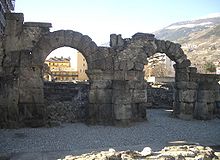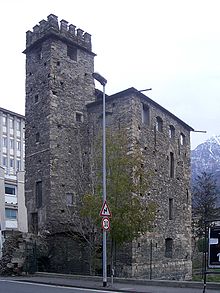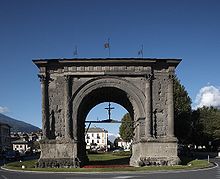- Aosta
-
Aoste redirects here. For the village Aoste in France, see Aoste, Isère.For the infantry division, see 28 Infantry Division Aosta
Aosta
Aoste— Comune — Città di Aosta
Ville d'AosteAerial view of Aosta 
Coat of armsLocation of Aosta in Italy Coordinates: 45°44′N 7°19′E / 45.733°N 7.317°ECoordinates: 45°44′N 7°19′E / 45.733°N 7.317°E Country Italy Region Aosta Valley Province none Frazioni Arpuilles, Cache, Champailler, Entrebin, Excenex, Laravoire, Porossan, Seyssinod, Signayes, Vignole, Cossan Government - Mayor Bruno Giordano Area - Total 21.37 km2 (8.3 sq mi) Elevation 583 m (1,913 ft) Population (21 December 2009) - Total 35,061 - Density 1,640.7/km2 (4,249.3/sq mi) Demonym Italian: aostani
French: AostoisTime zone CET (UTC+1) - Summer (DST) CEST (UTC+2) Postal code 11100 Dialing code 0165 Patron saint St. Gratus Saint day September 7 Website Official website Aosta
 listen (help·info) (French: Aoste, Arpitan: Aoûta) is the principal city of the bilingual Aosta Valley in the Italian Alps, 110 km (68 mi) north-northwest of Turin. It is situated near the Italian entrance of the Mont Blanc Tunnel, at the confluence of the Buthier and the Dora Baltea, and at the junction of the Great and Little St. Bernard routes. Aosta is not the capital of the province, as these functions are shared by the region and the communes.
listen (help·info) (French: Aoste, Arpitan: Aoûta) is the principal city of the bilingual Aosta Valley in the Italian Alps, 110 km (68 mi) north-northwest of Turin. It is situated near the Italian entrance of the Mont Blanc Tunnel, at the confluence of the Buthier and the Dora Baltea, and at the junction of the Great and Little St. Bernard routes. Aosta is not the capital of the province, as these functions are shared by the region and the communes.Contents
History
Aosta was settled in proto-historic times and later became a centre of the Salassi, many of whom were killed or sold into slavery by the Romans in 25 BC.[1] The campaign was led by Marcus Terentius Varro, who then founded the Roman colony of Augusta Praetoria Salassorum, housing 3,000 retired veterans. After 11 BC Aosta became the capital of the Alpes Graies ("Grey Alps") province of the Empire. Its position at the confluence of two rivers, at the end of the Great and the Little St Bernard Pass, gave it considerable military importance, and its layout was that of a Roman military camp.
After the fall of the Western Empire, the city was conquered, in turn, by the Burgundians, the Ostrogoths, the Byzantines. The Lombards, who had annexed it to their Italian kingdom, were expelled by the Frankish Empire under Pepin the Short. Under his son, Charlemagne, Aosta acquired importance as a post on the Via Francigena, leading from Aachen to Italy. After 888 AD it was part of the renewed Kingdom of Italy under Arduin of Ivrea and Berengar of Friuli.
In the 10th century Aosta became part of the Kingdom of Burgundy. After the fall of the latter in 1032, it became part of the lands of Count Humbert I of the House of Savoy. After the creation of the county of Savoy, with its capital in Chambéry, Aosta led the unification of Italy.
Under the House of Savoy, Aosta was granted a special status that it maintained when the new Italian Republic was proclaimed in 1948.
Main sights
Ancient remains
The ancient town walls of Augusta Praetoria Salassorum are still preserved almost in their entirety, enclosing a rectangle 725 by 571 m. They are 6.4 m high, built of concrete faced with small blocks of stone. At the bottom, the walls are nearly 2.75 m thick, and at the top 1.83 m.
Towers stand at angles to the enceinte and others are positioned at intervals, with two at each of the four gates, making twenty towers in total. They are roughly 6.5 m square, and project 4.3 m from the wall. Of the 20 original towers, the following are well preserved:
- Tour du lépreux, which has been given this name after a leper was jailed there in the late 17th century. Le lépreux de la cité d'Aoste, a novel by Xavier de Maistre, was named after this tower.
- Tour Neuve (13th century).
- Tour du Pailleron.
- Tower (Castle) of Bramafan, built in the 11th century over a Roman bastion. It was the residence of the Savoy viscounts. The Franco-Provençal term Bramafan is translated as "He who screams for hunger".
- Tour du Baillage.
- Tour Fromage.
The east and south gates exist intact. The latter, a double gate with three arches flanked by two towers known as the Porta Praetoria (1st century AD) was the eastern gate to the city, and has preserved its original forms apart from the marble covering. It is formed by two series of arches enclosing a small square.
The rectangular arrangement of the streets is modeled on a Roman plan dividing the town into 64 blocks (insulae). The main road, c. 10 m wide, divides the city into two equal halves, running from east to west. This arrangement makes it clear that guarding the road was the main raison d'être of the city.
The Roman theatre, of which the southern façade remains today, 22 m tall. The structure, dating from the late reign of Augustus, occupied an area of 81 x 64 m: it could contain up to 4,000 spectators. In the nearby was the amphitheatre, built under Claudius. A marketplace surrounded by storehouses on three sides with a temple in the centre with two on the open (south) side, as well as a thermae, also have been discovered.
Outside the town is a triumphal arch in honour of Augustus, built in 35 BC to celebrate the victory of consul Varro Murena over the Salassi. About 8 km to the west is a single-arched Roman bridge, called the Pont d'Aël. It has a closed passage, lighted by windows for foot passengers in winter, and above it an open footpath, both being about 10 m in width.
There are considerable remains of the ancient road from Eporedia (modern Ivrea) to Augusta Praetoria into the Aosta Valley. The modern railway follows this route, notable for the Pont Saint-Martin, which has a single arch with a span of 35 m and a roadway 4.5 m wide;
the cutting of Donnas; and the Roman bridges of Châtillon (Pont Saint-Vincent) and Aosta (Pont de Pierre).
Other sights
- The Cathedral, built in the 4th century and replaced in the 11th century by a new edifice dedicate to the Madonna. It is annexed to the Roman Forum.
- The Romanesque-Gothic Sant'Orso (Saint-Ours). Its most evocative feature is the cloister, which can be entered through a hall on the left of the façade. It is dedicated to Ursus of Aosta.
- The Saint-Bénin College, built about 1000 by the Benedictines. It is now an exhibition site.
Transport
Aosta railway station, opened in 1886, forms part of the Chivasso–Aosta railway, and is also a junction station for a branch line to nearby Pré-Saint-Didier, in the Valdigne, on the way towards Courmayeur.
Aosta Airport is a short distance to the east of the city.
See also
- Duke of Aosta
- Franco-Provençal language - Valdôtain dialect.
- French language, Aostan French
- Category:Towers in Italy
- Category:Tribes involved in Caesar's Gallic Wars
References
- ^ John Lemprière, Lorenzo DaPonte, & John David Ogilby (1839), Bibliotheca Classica: Or, A Dictionary of All the Principal Names and Terms, (Tenth American Edition), New York: W.E. Dean. Salassi, p. 281
 This article incorporates text from a publication now in the public domain: Chisholm, Hugh, ed (1911). Encyclopædia Britannica (11th ed.). Cambridge University Press.
This article incorporates text from a publication now in the public domain: Chisholm, Hugh, ed (1911). Encyclopædia Britannica (11th ed.). Cambridge University Press.
Further reading
- Carlo Promis, Le antichità di Aosta, (Turin, 1862);
- Édouard Bérard, Atti della Società di Archeologia di Torino, iii. 119 seq.; Notizie degli Scavi, passim;
- Alfredo d'Andrade, Relazione dell' Ufficio Regionale per la conservazione dei Monumenti del Piemonte e della Liguria (Turin, 1899), 46 seq.
External links
- Virtual Museum Vallée (VMV), virtual museum of Aosta city
- Augusta Praetoria Site plan & photos from the Aosta Valley Regional Authority.
- Ancient Places TV: HD Video of Aosta, Italy
Comuni of Aosta Valley Allein · Antey-Saint-André · Aosta · Arnad · Arvier · Avise · Ayas · Aymavilles · Bard · Bionaz · Brissogne · Brusson · Challand-Saint-Anselme · Challand-Saint-Victor · Chambave · Chamois · Champdepraz · Champorcher · Charvensod · Châtillon · Cogne · Courmayeur · Donnas · Doues · Emarèse · Etroubles · Fontainemore · Fénis · Gaby · Gignod · Gressan · Gressoney-La-Trinité · Gressoney-Saint-Jean · Hône · Introd · Issime · Issogne · Jovençan · La Magdeleine · La Salle · La Thuile · Lillianes · Montjovet · Morgex · Nus · Ollomont · Oyace · Perloz · Pollein · Pont-Saint-Martin · Pontboset · Pontey · Pré-Saint-Didier · Quart · Rhêmes-Notre-Dame · Rhêmes-Saint-Georges · Roisan · Saint-Christophe · Saint-Denis · Saint-Marcel · Saint-Nicolas · Saint-Oyen · Saint-Pierre · Saint-Rhémy-en-Bosses · Saint-Vincent · Sarre · Torgnon · Valgrisenche · Valpelline · Valsavarenche · Valtournenche · Verrayes · Verrès · VilleneuveRegional capitals of Italy L'Aquila, Abruzzo
Aosta, Aosta Valley
Bari, Apulia
Potenza, BasilicataBasilica di Sant'Andrea · Basilica of Superga · Castello della Manta · Fenestrelle Fort · Fénis Castle · Fort Bard · Gran Paradiso National Park · Historic center of Aosta · Mole Antonelliana · Museo Egizio · Residences of the Royal House of Savoy · Sacra di San Michele · Sacri Monti of PiedmontCategories:- Cities and towns in Aosta Valley
- Communes of Aosta Valley
- Aosta
- Roman amphitheatres in Italy
Wikimedia Foundation. 2010.







